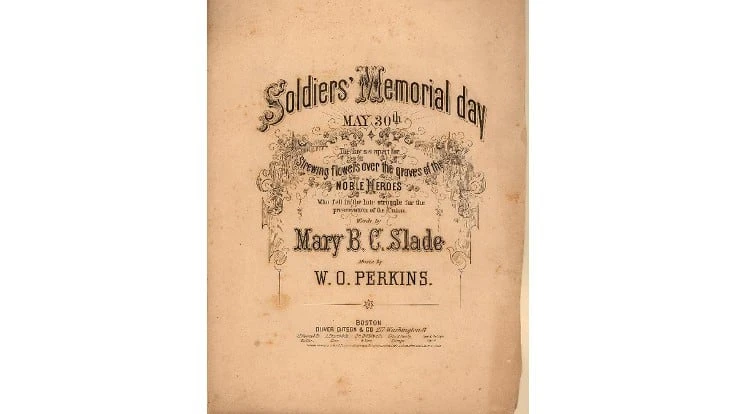
From the U.S. Library of Congress
The first national celebration of the holiday took place May 30, 1868, at Arlington National Cemetery, where both Confederate and Union soldiers were buried. Originally known as Decoration Day, at the turn of the century it was designated as Memorial Day. In many American towns, the day is celebrated with a parade.
Southern women decorated the graves of soldiers even before the Civil War’s end. Records show that by 1865, Mississippi, Virginia, and South Carolina all had precedents for Memorial Day. Songs in the Duke University collection Historic American Sheet MusicExternal include hymns published in the South such as these two from 1867: “Kneel Where Our Loves are Sleeping External,” dedicated to “The Ladies of the South Who are Decorating the Graves of the Confederate Dead ” and “Memorial Flowers External,” dedicated “To the Memory of Our Dead Heroes.”
When a women’s memorial association in Columbus, Mississippi, decorated the graves of both Confederate and Union soldiers on April 25, 1866, this act of generosity and reconciliation prompted an editorial piece, published by Horace Greeley’s New York Tribune, and a poem by Francis Miles Finch, “The Blue and the Grey,” published in the Atlantic Monthly. The practice of strewing flowers on soldiers’ graves soon became popular throughout the reunited nation.
President Lyndon Johnson proclaimed Waterloo, New York, as the “Birthplace of Memorial Day,” because it began a formal observance on May 5, 1866. However, Boalsburg, Pennsylvania, also claims to have held the first observance, based on an observance dating back to October 1864. Indeed, many other towns also lay claim to being the first to hold an observance.
In 1971, federal law changed the observance of the holiday to the last Monday in May and extended the honor to all soldiers who died in American wars. A few states continue to celebrate Memorial Day on May 30.
Today, national observance of the holiday still takes place at Arlington National Cemetery with the placing of a wreath on the Tomb of the Unknown Soldier and the decoration of each grave with a small American flag. Protocol for flying the American flag on Memorial Day includes raising it quickly to the top of the pole at sunrise, immediately lowering it to half-staff until noon, and displaying it at full staff from noon until sunset. For other guidelines see the Flag Code.
Many veterans of the Vietnam War, and relatives and friends of those who fought in that conflict, make a pilgrimage over Memorial Day weekend to the Vietnam Veterans Memorial in Washington, D.C., where they pay their respects to another generation of fallen soldiers.
Latest from Aerospace Manufacturing and Design
- Ulbrich Stainless Steels & Special Metals acquires two ATI operations
- Abaco Systems' SBC3215 high-performance, rugged single-board computer
- IMTS 2024 Booth Tour: Hurco
- Soracle to bring AAM services to Japan with Archer eVTOLs
- Veterans Day
- Carter Manufacturing's bearings for ultra-high vacuum applications
- IMTS 2024 Booth Tour: Greenleaf Corporation
- Register now for November’s Manufacturing Lunch + Learn!





